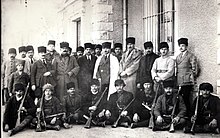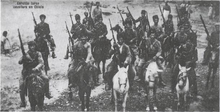Kuva-yi Milliye
This articleneeds additional citations forverification.(January 2021) |
| Kuvâ-yi Milliye | |
|---|---|
 Ethem the Circassian,hisCircassianmen (Kuva-yi Seyyare) andMustafa Kemal Pashain front of the main building of the station, who were on their way to the Yozgat rebellion (June 1920) | |
| Active | 1918–1921 |
| Country | Ottoman Empire |
| Allegiance | |
| Type | Militia |
| Role | Turkish Independence |
| Size | 5,000 (1919) 15,000 (peak in 1920)[1] |
| Motto(s) | Ya istiklâl ya ölüm! (Independence or death!)[citation needed] |
| Colors | RedandWhite |
| Engagements | Turkish War of Independence
|
| Commanders | |
| Notable commanders | Mustafa Kemal Pasha (Nominally commander-in-chief) Ethem the Circassian(Main commander until 1921) Yörük Ali Efe(Commander,Western Front) Şahin Bey(Commander,Southern Front) Topal Osman(Commander) |
TheKuva-yi Milliye(Ottoman Turkish:قواى مليه;lit.'National Forces'[2][3]or 'Nationalist Forces'[4]) were irregular Turkishmilitiaforces[4]active in the early period of theTurkish War of Independence.These irregular forces emerged after the occupation of the parts ofTurkeyby theAlliedforces in accordance with theArmistice of Mudros.Later,Kuva-yi Milliyewere integrated to theregular army(Kuva-yi Nizamiye)[4]of theGrand National Assembly.Some historians call this period (1918–20) of theTurkish War of Independencethe "Kuva-yi Milliye phase".[5]
History[edit]
This sectionneeds expansion.You can help byadding to it.(January 2021) |
In theArmistice of Mudros,Ottoman Empirewas divided between theAllies,where the Greeks occupied the west, the British occupied the capital and southeast, and the Italians and the French occupied the south of the country.
When the atrocities committed by the Greeks in the places they occupied became known among the people of Afyonkarahisar, the people began to harbor great hatred and anger against the Greeks. Realizing that the danger caused by the Greeks could harm them in a short time, the people of Afyonkarahisar, under the leadership of Lieutenant Colonel Arif Bey, formed the Afyonkarahisar Kuvâ-yi Milliye.[6]
TheKuva-yi Milliyewere the first armed groups to defend the Turks and Muslims' rights in Anatolia and Rumelia. TheKuva-yi Milliyeconsisted of deserted Ottoman army officers and militias. TheKuva-yi Milliyebecame active whenthe Greeks landed atSmyrna (İzmir).[citation needed]People who opposed the partitioning of Anatolia by the unratifiedTreaty of Sèvresjoined the resistance. TheFranco-Turkish Warwas almost exclusively conducted by Kuva-yi Milliye units on the Turkish side. In westernAnatolia,theKuva-yi Milliyefought against the Greek Army byhit-and-run tactics[7]until a regular army was set up. The resistance of theKuva-yi Milliyeslowed the Greek advance in Anatolia.[8]

Dissolution ofKuva-yi Milliye[edit]
This sectionneeds expansion.You can help byadding to it.(July 2011) |
Although theKuva-yi Milliyewas regarded as the first step of resistance in the liberation of Turkey, irregular warfare was abandoned later on. The militia lacked discipline and experience; it had no chance in larger open field battles against the Greeks. In September 1920, its members had to face and halt the advance of a highly trained and well equippedGreek Armynumbering more than 107,000 men with a force less than 15,000 on theWestern front.After theGrand National Assembly of Turkeywas opened, the regular army was created by merging differentKuva-yi Milliyegroups.Kuva-yi Milliyewas ultimately dissolved towards the end of 1920. Although some units of theKuva-yi Milliyestill fought on thesouthern frontuntil 1921. TheFirst Battle of İnönüis the first in which thestanding armyfought against the Greek forces.
Rebels[edit]
SomeKuva-yi Milliyegroups, most notablyÇerkes Ethem'sKuva-yi Seyyarerefused to disband his forces and mutinied against theAnkara Government.The Army of GNA defeated both the Greek Army and the Rebel Forces at the end of Turkish War of Independence.
See also[edit]
References[edit]
- ^Selek, Sabahattin (1987),Anadolu ihtilâli(in Turkish), vol. 1, Kastaş AŞ Yayınları, p. 127
- ^Akşin, Sina (2007),Turkey: From Empire to Revolutionary Republic: The Emergence of the Turkish Nation from 1789 to the Present,New York University Press, p. 126,ISBN978-0-8147-0722-7
- ^Shaw, Stanford J; Shaw, Ezel Kural (1977),History of the Ottoman Empire and Modern Turkey,vol. 2, Cambridge University Press, p. 341,ISBN978-0-521-29166-8
- ^abcSmith, Elaine Diana (1959),Turkey: Origins of the Kemalist Movement and The Government of the Grand National Assembly, 1919–1923,The American university, p. 68
- ^Kasalak, Kadir (November 1998),"Kuva-yı Milliye'nin Askeri Açıdan Etüdü",Atatürk Araştırma Merkezi Dergisi(in Turkish),XIV(42), Türkiye Cumhuriyeti'nin: 75,archivedfrom the original on 2011-12-10,retrieved2011-07-24.Yılı Özel Sayısı.
- ^Kaya, Şerife Burcu; Kaya, Ümit Ünsal; Bulut, Yakup (2023-03-30)."THE ROLE OF BAYAT IN THE TURKISH NATIONAL STRUGGLE PROCESS ON THE AXIS OF LIEUTENANT COLONEL (BAYATLI) ARIF BEY AND KARAKEÇILI NATIONAL REGIMENT".Karadeniz Uluslararası Bilimsel Dergi.1(57): 81–92.doi:10.17498/kdeniz.1242250.ISSN1308-6200.
- ^Belleten,vol. 65, Türk Tarih Kurumu, 2001,retrieved2010-08-18
- ^"Kuva‐i Milliye",Cum Huriyet,Etarih, archived fromthe originalon 2010-11-15,retrieved2010-08-18
External links[edit]
- Kasalak, Kadir (November 1998),Kuva-yı Milliye'nin Askeri Açıdan Etüdü,vol. XIV, Atatürk Araştirma Merkezi Dergisi,Türkiye Cumhuriyeti'nin 75. Yılı Özel Sayısı.
